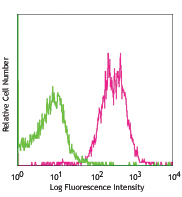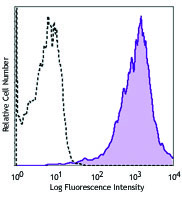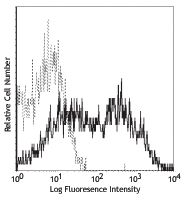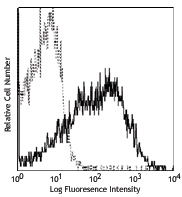- Regulatory Status
- RUO
- Other Names
- Multiplex assay, IFN-λ1(IL-29), IL-1β, IL-6, TNF-α, IP-10, IL-8, IL-12p70, IFN-α2, IFN-λ2 (IL-28A), GM-CSF, IFN-β, IL-10, IFN-γ
- Ave. Rating
- Submit a Review
- Product Citations
- publications
In response to pathogens, especially viruses, cells release interferons and other cytokines to fight the infections. Interferons are typically divided into three types: 1 (e.g., INF-α, IFN-β), 2 (e.g., IFN-γ), and 3 (e.g., IFN-λ1, IFN-λ2). All interferons are important for fighting viral infections and for regulating the immune system. In addition, interferons are critically involved in cancer and autoimmune diseases such as psoriasis, systemic lupus erythematosus, and multiple sclerosis. Studying the expression profile of interferons and other related cytokines is pivotal in understanding the immune responses against pathogens and disease-related processes.
The LEGENDplex™ Human Anti-Virus Response Panel is a bead-based multiplex assay, utilizing fluorescence–encoded beads suitable for use on various flow cytometers. This panel allows simultaneous quantification of 13 human proteins, including interferons (α, β, γ, λ1 and λ2), interleukins (1β, 6, 8, 10, 12), TNF-α, IP-10 and GM-CSF. The Type 1/2/3 Interferon Panel is a subpanel of the 13-plex Anti-Virus Response Panel, which allows for simultaneous quantification of the five Interferons. Both panels provide high sensitivities and broad dynamic range. The two panels have been validated for use on serum and cell culture supernatant samples. Use plasma samples with caution due to sample viscosity and existence of particulates in such samples.
The Human Anti-Virus Response Panel is designed to allow flexible customization.
Kit Contents
- Kit Contents
-
- Setup Beads: PE Beads
- Setup Beads: Raw Beads
- LEGENDplex™ Human Anti-Virus Response Panel 1 V02 Premixed Beads
- LEGENDplex™ Human Anti-Virus Response Panel 1 V02 Detection Antibodies
- LEGENDplex™ Human Anti-Virus Response Panel 1 V02 Standard
- LEGENDplex™ Matrix A, Lyophilized
- LEGENDplex™ SA-PE
- LEGENDplex™ Assay Buffer
- LEGENDplex™ Wash Buffer, 20X
- Plate Sealers
- Filter plate
Product Details
- Verified Reactivity
- Human
- Application
-
Multiplex - Panel
Learn more about LEGENDplex™ at biolegend.com/legendplex
Download the LEGENDplex™ software here. - Materials Not Included
-
- Flow cytometer
- Pipettes and Tips
- Reagent reservoirs for multichannel pipette
- Polypropylene microcentrifuge tubes (1.5 mL)
- Laboratory vortex mixer
- Sonicator bath
- Aluminum foil
- Absorbent pads or paper towels
- Plate shaker
- Tabletop centrifuges
- A Vacuum Filtration Unit and a Vacuum Source (if using filter plates)
- 1.1 mL polypropylene micro FACS tubes, in 96-tube rack
- Manual
Antigen Details
- Biology Area
- COVID-19, Immunology, Innate Immunity
- Molecular Family
- Cytokines/Chemokines
- Gene ID
- 282616 View all products for this Gene ID 3553 View all products for this Gene ID 3576 View all products for this Gene ID 282618 View all products for this Gene ID 3456 View all products for this Gene ID 3440 View all products for this Gene ID 3458 View all products for this Gene ID 3569 View all products for this Gene ID 3586 View all products for this Gene ID 7124 View all products for this Gene ID 3592 View all products for this Gene ID 3593 View all products for this Gene ID 1437 View all products for this Gene ID 3627 View all products for this Gene ID
Related Pages & Pathways
Pages
Related FAQs
- If I don't have a vacuum, how do I remove the liquid from my plate?
-
If you do not have a vacuum, the assay should be run in a V-bottom plate. After centrifugation using a swinging-bucket rotor with a plate adaptor, you can remove the liquid by flicking the plate quickly, dumping the contents into a sink, and patting it dry carefully on a stack of clean paper towels without losing the beads. Alternatively, you can remove the liquid by using a pipette.
- Should I perform the assay with the filter plates or with V-bottom plates?
-
Filter plates or V-bottom plates have been included in some kits for your convenience. A vacuum filtration unit is required to work with the filter plates. However, if you don’t have access to a vacuum manifold or if you prefer, then you can use the V-bottom plates and follow the recommended assay protocols for the type of plates you choose. All plates should be made from low binding polypropylene. Polystyrene ELISA or cell culture plates should not be used.
- After I finish the staining process, how long can I wait before reading my LEGENDplex™ samples?
-
The samples can be kept overnight at 4°C while being protected from exposure to light and be read the next day. There may be a decrease in signal, but overall, the assay results should not be affected. Storing the samples for extended periods of time is not recommended, as it could lead to further reductions in signal.
- What is the shelf life of LEGENDplex™ kits?
-
LEGENDplex™ kits are guaranteed for 6 months from the date of receipt, but may have a shelf life of up to 2 years from the date of manufacture.
- Is special software required for data analysis?
-
Typically flow cytometers generate output files in FCS format (e.g. FCS 2.0, 3.0, or 3.1) and in some cases in list mode file format (LMD). Other software may be available to analyze FCS files. Data generated using LEGENDplex™ kits can be analyzed using the freely available LEGENDplex™ data analysis software. Please check our website for the most updated versions of the software.
Customers Also Purchased





 Login / Register
Login / Register 








Follow Us